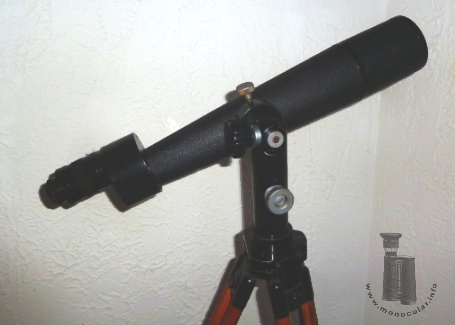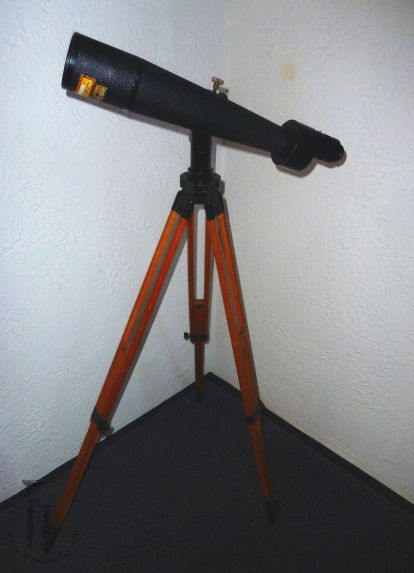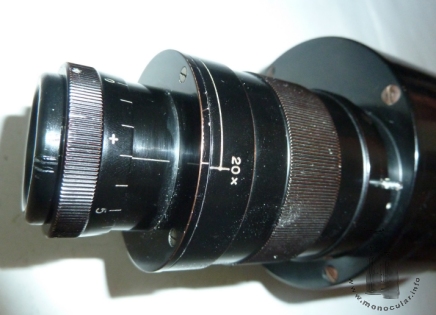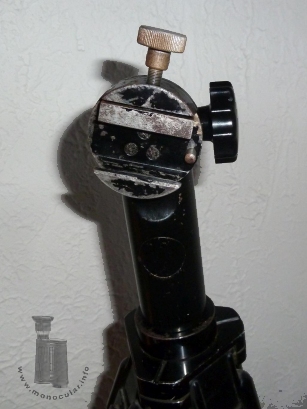Carl Zeiss 20-40x80 ("Asem" 80/500)
| Bei dem hier gezeigten Prismenteleskop von VEB Zeiss handelt es sich um eine Sonderausführung oder Prototyp für ein monokulares 80/500 aus der Nachkriegszeit (evtl. schon um 1950), wie es binokular längere Zeit gefertigt wurde. Alle Merkmale weisen auf ein Carl Zeiss Fabrikat hin und es stellt einen Nachfolger des Vorkriegsmodells "Asem" dar; das Stativ ist original und passend für die seitliche Schwalbenschwanzmontierung. Zwar gibt es keine Beschriftung an dem Monokular, aber typische DDR-Aufkleber (gelb mit roter Umrandung) am Tubus und am Stativ weisen es als "Volkseigentum" der Friedrich-Schiller-Universität Jena (Inv.Nr. 30414) aus. | The monocular prism telescope shown here is a prototype or special edition of a 80/500 telescope made by VEB Zeiss Jena after WWII. (maybe already about 1950). This type was fabricated as a binocular for a longer period. All characteristics show a typical Carl Zeiss Jena design. It can be considered a successor to the pre-war "Asem" model. The tripod is original and fits to the dove-tail mount of the telescope. Although there is no inscription on the monocular, it comes with typical GDR stickers (yellow with a red outline) on the tube and on the tripod leg denoting that it is a "Volkseigentum" (= people's property) of the Friedruch-Schiller University in Jena (Inventory number 30414). |


| Wie die Binokulare hat es ein (halb)pankratisches Okular von 20x und 40x Vergrößerung. Allerdings lässt sich die Vergrößerung durch Drehen des dickeren Okulartubuses durchaus stufenlos verändern. Beim jeweiligen endenden Anschlag erhält man die 20- oder 40-fache Vergrößerung. Die Fokussierung geschieht durch einen umlaufenden Dioptrienausgleich markiert bei +/-5 am Okularstück. Es hat ein Porro-2-Prismensystem. Die Optik ist blau vergütet. Die flache Augenmuschel ist aus Kunststoff. Das Monokulare Fernrohr 80/500 ist schwarz lackiert. Das Okularstück, Prismengehäuse und die Zierringe sind mit glatter Oberfläche, der konische Tubus hat ein Art strukturierten Raulack. Seitlich am Tubus ist eine Schwalbenschwanzmontierung angeschraubt. |
Like the binocular models it has a semi-pancratic eyepiece of 20x and 40x power, although the magnification can be zoomed continuously. When turning the zoom ring the end stop renders the minimum of 20x and the maximum of 40x. Focusing is done by dioptre adjustment marked on the full division scale at +/-5. The telescope has a porro 2 prism system. The optics are coated blue. The shallow eyecup is made of plastic. The monocular telescope 80/500 is lacquered black. The eyepiece, the prism housing and the decoration rings have a smooth finish, the conical tube has a textured paint. The dove-tail mount is screwed onto the tube sideays. |



| Das Monokulare Fernrohr 80/550 ist 60-61cm lang. Der konische Haupttubus verbreitert sich von 52mm auf 96mm im Durchmesser. Das Objektiv ist ca. 65mm in den geraden Objektivtubus hinein versetzt. Die Schwalbenschwanzmontierung misst 56x37mm. Das 58mm lange Prismengehäuse ist 98mm im Durchmesser. Das Okularstück ist beim geriffelten Zoomring 58mm, beim schmaleren Okulartubus 37mm, beim Fokussierungsring 39mm und die Augenmuschel 35mm im Durchmesser. Das Fernrohr wiegt 3215g. | The monocular telescope 80/550 is 60-61cm long. The conical main tube increases from 52mm to 96mm in diameter. The objective is retracted by c. 65mm into the straight obejctive tube end. The dove-tail mount measures 56x37mm. The 58mm long prism housing is 98mm in diameter. The zoom ring is 58mm, the smaller ocular tube 37mm, the focusing ring 39mm, and the eyecup 35mm in diameter. The telescope weighs 3215g. |
Fotos: Zeun

